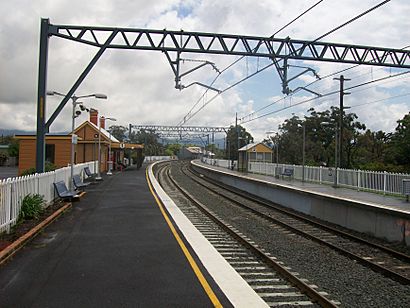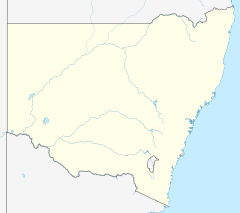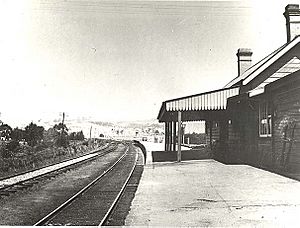Albion Park railway station facts for kids
Quick facts for kids
Albion Park
|
|||||||||||
|---|---|---|---|---|---|---|---|---|---|---|---|
 |
|||||||||||
| Location | Princes Highway, Albion Park Rail, New South Wales Australia |
||||||||||
| Coordinates | 34°33′48″S 150°47′57″E / 34.5633°S 150.7991°E | ||||||||||
| Owned by | Transport Asset Holding Entity | ||||||||||
| Operated by | NSW TrainLink | ||||||||||
| Line(s) | South Coast | ||||||||||
| Distance | 103.341 km (64.213 mi) from Central | ||||||||||
| Platforms | 2 side (212 and 196 metres) | ||||||||||
| Train operators | NSW TrainLink | ||||||||||
| Bus operators |
|
||||||||||
| Connections | Coach | ||||||||||
| Construction | |||||||||||
| Structure type | At-grade | ||||||||||
| Parking | Yes | ||||||||||
| Bicycle facilities | Bike racks | ||||||||||
| Disabled access | Easy Access | ||||||||||
| Architectural style | Late Victorian | ||||||||||
| Other information | |||||||||||
| Website | Transport for NSW | ||||||||||
| History | |||||||||||
| Opened | 9 November 1887 | ||||||||||
| Electrified | 17 November 2001 | ||||||||||
| Previous names | Oak Flats | ||||||||||
| Traffic | |||||||||||
| Passengers (2013) | 260 (daily) (Sydney Trains, NSW TrainLink) | ||||||||||
| Rank | 214 | ||||||||||
| Services | |||||||||||
|
|||||||||||
| Official name | Albion Park Railway Station Group | ||||||||||
| Type | State heritage (complex / group) | ||||||||||
| Designated | 2 April 1999 | ||||||||||
| Reference no. | 1072 | ||||||||||
| Type | Railway Platform / Station | ||||||||||
| Category | Transport - Rail | ||||||||||
| Builders |
|
||||||||||
| Location | |||||||||||
Albion Park railway station is a train station in Albion Park Rail, Australia. It's on the South Coast railway line. The station is considered a special historical place because of its old design. It was built in 1887 by William Monie & Company. The railway line itself was built by D. Proudfoot & T Logan. This station is also known as the Albion Park Railway Station Group. It was added to the New South Wales State Heritage Register on April 2, 1999, which means it's protected for its historical importance.
Contents
History of Albion Park Station
The town of Shellharbour was first planned in 1851. The local council moved to Albion Park in 1897. This happened as Shellharbour became less important and Albion Park grew. Albion Park was a busy area for raising cattle and dairy farming.
When engineers planned the Illawarra railway line in the 1880s, they needed flat ground. This was important for the steam trains of that time. So, the railway line was built a bit far from the main towns of Albion Park and Shellharbour.
The station we know as Albion Park opened on November 9, 1887. It was first called "Oak Flats". This was part of the railway line that connected Wollongong to Bombo. At the same time, another station called "Albion Park" opened about 3 kilometres (1.9 miles) north. The next year, the names changed. The "Albion Park" station became Yallah, and "Oak Flats" became Albion Park. A new Oak Flats station opened later in 1890. Yallah Station closed in 1974.
Albion Park station became an important place south of Wollongong. It had a large yard for trains. The buildings were some of the last ones built before railway designs became more standard around 1890. When it first opened, the station had a loop for trains to cross. It also had a siding for goods, which included a shed for loading items. In 1885, a brick house for the station master was built. In 1890, a signal box was added. Later, in 1913, a special siding was built for the Central Co-operative Dairy Company factory. This factory is still there today.
Because of the dairy and farming industries, the area around the station grew. It became a small town called Albion Park Rail in 1921. This name showed its connection to the railway.
In 2001, the railway line from Dapto to Kiama was updated. It was changed to use electricity. A second platform was built. This allowed more trains to run and cross paths. Also in 2001, the old station master's house was sold. In 2013, the crossing between the two platforms was changed to make it easier for people in wheelchairs to use.
Platforms and Train Services
Albion Park station has two platforms, one on each side of the tracks.
- Platform 1 is for trains heading north towards Sydney Central and Bondi Junction.
- Platform 2 is for trains heading south towards Kiama.
These trains are part of the NSW TrainLink South Coast line services.
| Platform | Line | Stopping pattern | Notes |
| 1 |
NSW TrainLink
|
services to Sydney Central & Bondi Junction | |
|---|---|---|---|
| 2 |
NSW TrainLink
|
services to Kiama |
Getting Around: Transport Links
Several bus routes stop at Albion Park station, run by Premier Illawarra:
- Route 37: Travels from Wollongong Beach to Wollongong station. It goes through Oak Flats and Shellharbour in an anti-clockwise loop.
- Route 57: Travels from Wollongong station to Wollongong Beach. It goes through Shellharbour and Oak Flats in a clockwise loop.
- Route 77: Connects Albion Park to Stockland Shellharbour.
You can also catch NSW TrainLink coach services from Albion Park. These coaches travel between Wollongong and Bundanoon.
Why Albion Park Station is Special (Heritage Listing)
Albion Park Railway Station is very important to the history of New South Wales. It's listed on the State Heritage Register. This means it's protected because of its special past and design.
Historical Importance
The station is important because it was a major place for moving goods, especially for the dairy and farming industries. Many of its original buildings from 1887-1890 are still there. These buildings were built before railway designs became standard, making them quite unique. The station also shows its connection to the Central Co-operative Dairy Company factory, which had its own train siding.
Design and Beauty
The station buildings are made of weatherboard and show the style of the late Victorian period (1887-1890). The main platform building is one of the best-preserved examples of its kind on the Illawarra line. The old signalling equipment inside the signal box also shows how railway technology used to work.
Community Connection
The station helps connect the local community to its past. It's a reminder of how the area developed and grew.
Research Value
The old signalling equipment in the signal box, like the signal levers, can teach us a lot about how railways operated in the past.
Rarity
It's rare to find a collection of weatherboard station buildings like those at Albion Park. Many stations from the late 19th century no longer have their original buildings. The platform building is one of only four of its specific type on the Illawarra line, and it's one of the most complete examples.
Good Example
The platform building is a great example of a "third class" weatherboard station building. The old signalling equipment also represents how railway technology worked historically.



